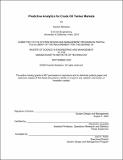| dc.contributor.advisor | Alexandre Jacquillat. | |
| dc.contributor.author | Babakan, Kayhan. | en_US |
| dc.contributor.other | Massachusetts Institute of Technology. Engineering and Management Program. | en_US |
| dc.contributor.other | System Design and Management Program. | en_US |
| dc.date.accessioned | 2021-10-08T16:48:05Z | |
| dc.date.available | 2021-10-08T16:48:05Z | |
| dc.date.copyright | 2020 | en_US |
| dc.date.issued | 2020 | en_US |
| dc.identifier.uri | https://hdl.handle.net/1721.1/132802 | |
| dc.description | Thesis: S.M. in Engineering and Management, Massachusetts Institute of Technology, System Design and Management Program, September, 2020 | en_US |
| dc.description | Cataloged from the official version of thesis. | en_US |
| dc.description | Includes bibliographical references (pages 69-70). | en_US |
| dc.description.abstract | Tanker markets are one of the many markets to experience extreme volatility, historically realizing drastic swings in earnings of up to 260% week over week. This volatility has placed pressure on tanker market participants to forecast future returns, create guidance for their investment decisions, and develop an analytical advantage. In this thesis, we develop analytics models to predict average earnings in the VLCC and Suezmax tanker market segments. Through the use of principal components regression, we forecast market returns with endogenous and exogenous market factors. A challenge lies in the fact that key variables--supply, demand, and utilization--are not necessarily available at the time of prediction. Accordingly, we develop an original two-step framework that first predicts vessel supply using classification models, and then embeds the imputed variables into the downstream principal components regression model. Methodologically, this procedure provides a novel approach to integrate classification outputs into a downstream predictive model. Based on our findings, we apply the forecast to two investment decisions; how to hedge the tanker market using time charter contracts and how to determine the optimal economic approach to lightering considering uncertainty in demand and in market returns. In both instances, we demonstrate how the use of an accurate tanker market forecast can be leveraged to make better managerial decisions, historically amounting up to 35 million dollars per year in the lightering decision and 10 million dollars per contract in the time charter investment. | en_US |
| dc.description.statementofresponsibility | by Kayhan Babakan. | en_US |
| dc.format.extent | 70 pages | en_US |
| dc.language.iso | eng | en_US |
| dc.publisher | Massachusetts Institute of Technology | en_US |
| dc.rights | MIT theses may be protected by copyright. Please reuse MIT thesis content according to the MIT Libraries Permissions Policy, which is available through the URL provided. | en_US |
| dc.rights.uri | http://dspace.mit.edu/handle/1721.1/7582 | en_US |
| dc.subject | Engineering and Management Program. | en_US |
| dc.subject | System Design and Management Program. | en_US |
| dc.title | Predictive analytics for crude oil tanker markets | en_US |
| dc.type | Thesis | en_US |
| dc.description.degree | S.M. in Engineering and Management | en_US |
| dc.contributor.department | Massachusetts Institute of Technology. Engineering and Management Program | en_US |
| dc.identifier.oclc | 1262986988 | en_US |
| dc.description.collection | S.M.inEngineeringandManagement Massachusetts Institute of Technology, System Design and Management Program | en_US |
| dspace.imported | 2021-10-08T16:48:05Z | en_US |
| mit.thesis.degree | Master | en_US |
| mit.thesis.department | SysDes | en_US |
